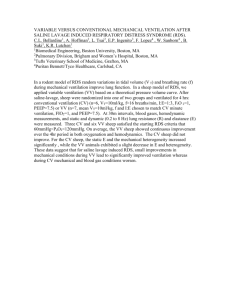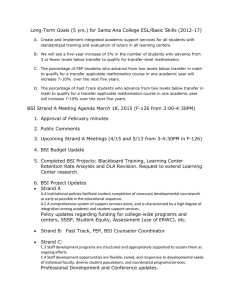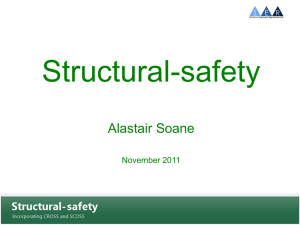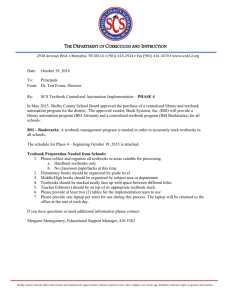LJMU, 11th Conference on PAVEMENT ENGINEERING AND
advertisement
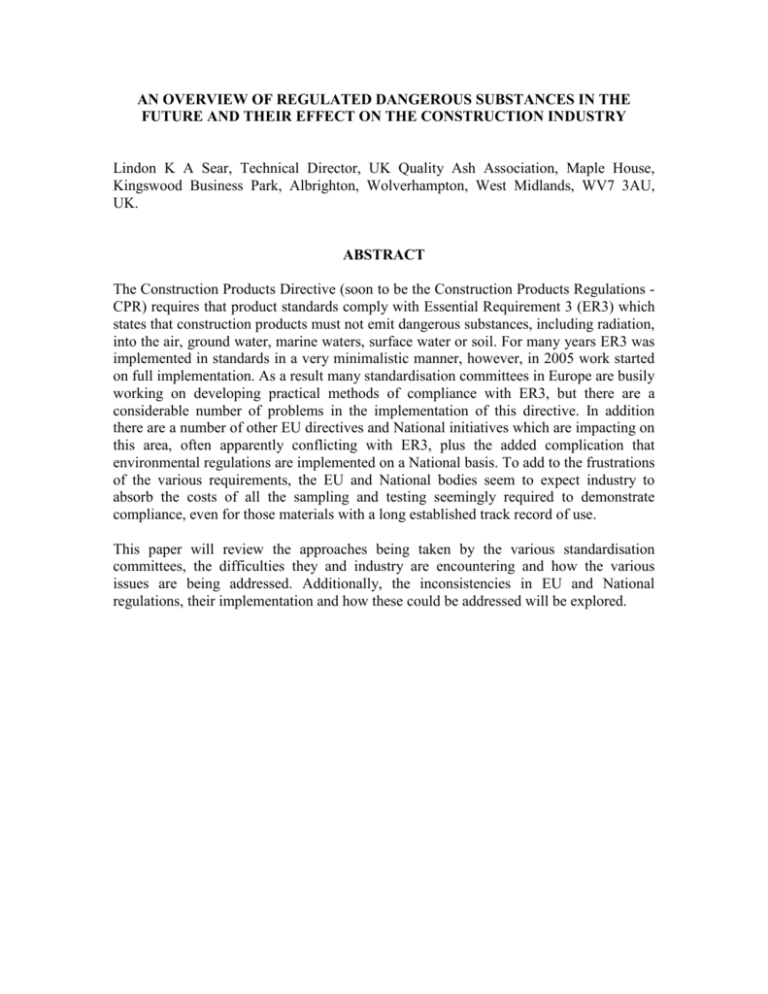
AN OVERVIEW OF REGULATED DANGEROUS SUBSTANCES IN THE FUTURE AND THEIR EFFECT ON THE CONSTRUCTION INDUSTRY Lindon K A Sear, Technical Director, UK Quality Ash Association, Maple House, Kingswood Business Park, Albrighton, Wolverhampton, West Midlands, WV7 3AU, UK. ABSTRACT The Construction Products Directive (soon to be the Construction Products Regulations CPR) requires that product standards comply with Essential Requirement 3 (ER3) which states that construction products must not emit dangerous substances, including radiation, into the air, ground water, marine waters, surface water or soil. For many years ER3 was implemented in standards in a very minimalistic manner, however, in 2005 work started on full implementation. As a result many standardisation committees in Europe are busily working on developing practical methods of compliance with ER3, but there are a considerable number of problems in the implementation of this directive. In addition there are a number of other EU directives and National initiatives which are impacting on this area, often apparently conflicting with ER3, plus the added complication that environmental regulations are implemented on a National basis. To add to the frustrations of the various requirements, the EU and National bodies seem to expect industry to absorb the costs of all the sampling and testing seemingly required to demonstrate compliance, even for those materials with a long established track record of use. This paper will review the approaches being taken by the various standardisation committees, the difficulties they and industry are encountering and how the various issues are being addressed. Additionally, the inconsistencies in EU and National regulations, their implementation and how these could be addressed will be explored. Introduction Regulated Dangerous Substances (RDS) is considered by the EU Commission as a potential barrier to trade. This is because some countries, most notably the Netherlands (State of Netherlands, 2007) and Germany, have specific regulations on the potential for leaching of potentially dangerous substances from construction products into the soil. There are also regulations relating to indoor air quality. However, as health and the environment requirements have always been based on National regulation, there is a theoretical technical issue that these could be used as a barrier to free trade within the EU. The issue of potential barriers to trade from RDS are addressed within Essential Requirement 3 (ER3) of the Construction Products Directive (CPD) (EEC, 1988) which requires that the following environmental aspects are addressed in product standards; Hygiene, health and the environment The construction work must be designed and built in such a way that it will not be a threat to the hygiene or health of the occupants or neighbours, in particular as a result of any of the following: the giving-off of toxic gas, the presence of dangerous particles or gases in the air. the emission of dangerous radiation pollution or poisoning of the water or soil, faulty elimination of waste water, smoke, solid or liquid wastes, the presence of damp in parts of the works or on surfaces within the works. The requirement is applied to five specific aspects of construction; Indoor environment Water supply Waste water disposal Solid waste disposal Outdoor environment NB: Noise protection is dealt with in another Interpretative Document. In existing product standards these issues were addressed in a minimalistic manner, for example within EN450-1:2005 the text states; 5.4.2 Release of dangerous substances and emission of radioactivity Fly ash shall not contain substances which, when released from concrete, are dangerous for health, hygiene and the environment. See Annex A (normative). However, things are about to change commencing with the introduction of the Construction Products Regulations (CPR) (UK Gov, 2011) which is effective from 1 July 2013, followed by the full implementation of RDS. Construction Products Regulations (CPR) Unlike the CPD, CPR is an EU regulation requiring reliable information on construction products to be provided in the form of declarations of performance for essential characteristics related to health, safety and comfort as required by EU member states building regulations. As an EU regulation it becomes part of UK law by default, without change. In practical terms CPR will mean that if a harmonised product standard exists for a material for a specific application, for example EN450-1 Fly ash for concrete, then from 1 July 2013 it will be illegal to place such a product on the market unless it is CE marked and can demonstrate compliance with the standard. For construction applications this will affect for example aggregates, asphalt, building lime, cements and additions, factory made mortar, render and screeds. However, it does not affect the manufacture of concrete to EN206 or Hydraulically Bound Mixtures to EN14227, as these are not harmonised standards and have no requirement for CE marking in respect of existing requirements. In fact producing concrete with a CE mark purporting to comply with a non-harmonised standard will be a criminal offence! Regulated Dangerous Substances (RDS) For those already supplying to product standards, the introduction of the CPR will in general terms have little immediate effect, until the requirements for RDS are reflected in the standard. It is expected that some fine tuning of product standards will be required before 1 July 2013 where ‘essential requirements’ are not listed or require only a statement of pass or fail within Annex ZA of a standard. In future a value will have to be given for all essential requirements. The areas where the greatest changes will appear all relate to the requirements of ER3 and specifically Regulated Dangerous Substances (RDS), which will eventually be incorporated into product standards. This will effect both EN206 (Concrete) and EN14227 (HBM) as these materials are included within the appropriate mandates. Barriers to Trade and test methods While product standardisation committees are responsible for incorporating the requirements of the mandate in their standards, the test methods for determining the content of RDS are the responsibility of separate CEN Technical Committee, TC351. This group were tasked in producing harmonised test methods by which both the content and leaching potential of the substances could be determined. One of the first pieces of work carried out by TC351 was a Technical Report (BSI, 2009 (1)) on the existing and potential barriers to trade. In fact very few technical barriers to trade were identified where numerous differing test methods were in use. However, barriers to use were identified, such as National certification schemes which were identified as a problem. This was particularly an issue with indoor air quality. It was also suggested that without harmonised testing methods, there was the potential for technical barriers to be created in the future. For the development of environmental test methods CEN Guide 13 which describes how this is achieved, see Figure 1. The test methods will initially be published as Technical Specifications after robustness testing and thereafter as harmonised standards after validation testing. The working titles of these methods, based on the new work items agreed by CEN in January 2011, are as follows; 1. TS 1- Guidance standard for CEN Product TC’s for selection of leaching tests appropriate for their product(s) – General principles (BSI , 2010 (1)) 2. TS 2 - Generic horizontal dynamic surface leaching test (DSLT) for determination of surface dependent release of substances from monolithic or plate-like or sheet-like construction products (BSI, Figure 1 - Flow chart from CEN Guide 13 2010 (2)) 3. TS 3 - Generic horizontal upflow percolation test for determination of the release of substances from granular construction products (BSI , 2010 (3)) 4. Construction products – Assessment of emissions of regulated dangerous substances – Determination of emissions into indoor air (using ISO 16000-9). TS1 describes how a product should be assessed and the selection of one of the two test methods, e.g. TS2 or TS3. A flow diagram, see Figure 2, describes the decisions required, though this has attracted some criticisms and alternative flow charts have been submitted (BSI, 2011 (2)). TS2 describes the test method for surface leaching, but also includes an annex for coarse granular and compacted Granular construction products (CGLT mode). TS3 describes the upflow percolation test method. Figure 2 - Select of a test to assess release from a construction product For radiation, there are long established test methods and requirements through the Euratom Treaty (EURATOM, 1957) and the Basic Safety Standards Directive (EURATOM, 1996) associated with radioactivity. Gamma ray spectrography is considered the only testing likely to be relevant. The difficulties here relate to the calculations associated with producing a dose assessment, as these differ across the Member States. Work is on-going to harmonise the method and produce an EN standard. Radon exhalation is not considered to be an issue (BSI, 2011(3)), because this relates to natural background radon gas emissions and also to the method of construction employed. TC351 first came into existence in 2005, but has only just registered formal work items, as above, for the standards it was created to produce. However, in reality these standards are already in existence in the form of similar testing standards for characterisation of waste (TC292) that are published. The problem for TC351 has been that for these to be harmonised standards there is a CEN requirement that such standards are validated, e.g. the test methods work and are sufficiently robust that repeatable and reproducible results are obtained. Robustness and validation TC351’s timetable is that samples of various materials will be collected and tested. From the testing proposals for amendments to the draft Technical Specifications (TS) will be made (Feb 2012). A robustness evaluation from the test data will be complete in early April 2012. Comments from the various Working Groups (WG) will be reviewed by end of September 2012 and finally the TSs will be produced with the definitive text being available in July 2013. Thereafter, inter-laboratory or round robin testing will be carried out commencing July 2014 at a cost of ~€30,000,000. Samples for this work are expected to be supplied by industry at no cost. This data will be analysed and incorporated in prEN standards, which will go for enquiry in ~March 2015, with formal vote in ~September 2016 and the final standards being published in January 2017! The extended time periods associated with procedure, means that RDS could not be incorporated within standards until post 2017, the test methods being critical to the requirements, as in Figure 3. Figure 3 – Timeline of Events Attestation of conformity As is common with most harmonised standards RDS will have to be given some level of attestation. Attestation of level 1+ requires third party accreditation for compliance, whereas level 4 is effectively self-certification and third party bodies are not involved. The notified bodies have a working group known as SH01 working on RDS, which was supposed to meet for the first time on 30 June 2011 – but according to the Group of Notified Bodies web site, no meetings have been held. Exactly what level of attestation is going to be assigned to RDS is also not clear, though one would suspect that a higher level is likely considering the importance of environmental compliance. Products standardisation committees RDS will affect all product standards eventually. With many products it will be relatively easy to evaluate and produce the required statement of compliance. However, products that may consist of a wide range of constituents potentially have a serious problem. How the various product standardisation committees are tackling the issue follows. Over a period of some years upon revision all EU standards will have specific clauses relating to RDS. The parameters that require testing are detailed in the Mandate covering the product standard. Therefore the contents of the new mandates are of particular interest. Mandate M124 covers road construction materials, including bituminous bound mixtures, surface treatments, ancillary products, bridge deck waterproofing, etc but not hydraulically bound mixtures. M124 will also be extended to cover Unbound Aggregates for road construction. M125 covers aggregates for mortar, concrete, bound and unbound use in road construction and railway ballast. M128 cover concrete, mortar and grouts. TC154, Aggregates TC154, the CEN Technical Committee charged with producing products standards, has been surprisingly proactive in grasping the issues associated with RDS, being one of the first product committees to attempt to incorporate these requirements within their documents. The revised version of M124 has yet to be published and at the time of writing M125 was subject to amendment. The substances listed in the draft M125 in early versions were extensive being based on the various National requirements; for recycled aggregates from crushed concrete and bricks Release: pH / electrical conductivity / chloride (Cl) / sulphate (SO4) / arsenic (As) / lead (Pb) / cadmium (Cd) / chromium (Cr) / copper (Cu) / nickel (Ni) / mercury (Hg) / zinc (Zn) / phenol. Content: hydrocarbons / PAH / EOX / PCB / ammonium-N / nitrite-N for other recycled aggregates and certain manufactured aggregates, (such as steel slag, municipal waste incineration slag, fly ash and bottom ash from cocombustion) additionally Release: turbidity / tendency to produce foam / AOX / antimony (Sb) / barium (Ba) / boron (B) / cobalt (Co) / chromium VI / molybdenum (Mo) / selenium (Se) / thallium (Tl) / tin (Sn) / vanadium (V) / cyanide, (CN-) / fluoride (F-) / PAH / naphthalene and methylnaphthalenes / highly volatile halogenated hydrocarbons / 1,2-dichloroethane / tri- and tetrachloroethene / chloroethene (vinyl chloride) / alkylated benzenes / benzene / ethylbenzene / toluene / xylenes / MTBE / nonylphenol / chlorinated phenols / hexachlorobenzene / chlorobenzenes / epichlorohydrin Content: TOC / arsenic / lead / barium / cadmium / chromium (total) / cobalt / molybdenum / nickel / mercury / selenium / thallium / tin / vanadium / zinc / chloride / cyanide / fluoride / sulphate / PAH / / PCDDs and PCDFs / highly volatile halogenated hydrocarbons / PCBs / hydrocarbons / benzene / ethylbenzene / toluene / xylenes / radioactivity One will immediately observe that many of these substances will be relevant to some materials and not to others, for example fly ash from co-combustion will not contain highly volatile organic compounds as these would be burned within the furnace. The list also precludes natural aggregates, presuming them to be safe to the environment. However, this cannot be inherently true as many toxic materials, such as arsenic, are naturally occurring. TC154 have introduced a coding system for source specific materials that have been considered in the development of the standards. This coding system is likely to form the basis of source specific RDS requirements. In ‘the answer to the Mandate’ (BSI, 2011 (5)), TC154 have suggested a shorter list of only the following substances as being relevant; Mineral oil Molybdenum Lead Tin Bromide Chromium Selenium Cadmium Antimony Fluoride Copper Vanadium Nickel Arsenic Sulfate Cobalt Zinc Mercury Barium Chloride In comparison, one of the most recent draft mandates published for comment, M116 for Masonry products, has the following text for RDS; Radiation (radium, uranium, radon, potassium, thorium), Arsenic; Barium; Bromine;Cadmium; Chlorine; Chromium, total; Cobalt; Copper; Fluoride; Lead; Mercury; Molybdenum; Nickel; Selenium; Tin; Sulphate; Vanadium; Zinc, Polycyclic Aromatic Hydrocarbons (PAH); (Anthracene; Benzo(a)anthracene; Benzo(a)pyrene; Benzo(ghi)perylene; Benzo(k)fluoranthene; Chrysene; luoranthene; Indeno(1,2,3cd)pyrene; Naphthalene; Phenantrene;) Mineral Oil; Benzene; Ethylbenzene; Toluene; Xylenes; Trichlorethylene, ethylhexyl phtalate, dibutyl phthalate. While noting that the draft M125 text was material type specific, the M116 text would appear to be non-specific, e.g. ALL materials for Masonry products have to be tested. Radioactivity is treated somewhat differently as there are overarching EU regulations on limiting radiation in structures. For road construction applications, radiation is not considered an issue, however, for other applications it could easily become an area of concern. TC154, the committee responsible for aggregates standards have taken a very proactive approach to RDS for some time. Their original intention was to introduce RDS requirements within the current revisions of the various aggregate standards. However, the slow progress of TC351 in validating the harmonised test standards resulted in TC154 not being able to incorporate any such requirements on RDS. These standards should be published during 2012/2013. However, frustration has been expressed by TC154 (BSI, 2011 (1)) at the extended time periods associated with the work of TC351, which has already been in existence since 2005 and hasn’t as yet published the final draft TS text for the test methods. TC154 has proposed an alternative approach that existing testing standards could be adopted for RDS purposes; 1. EN 1744-1:2009 Tests for chemical properties of aggregates - Part 1: Chemical analysis 2. EN 1744-3:2002 Tests for chemical properties of aggregates - Part 3: Preparation of eluates by leaching of aggregates 3. EN 1744-4:2005 Tests for chemical properties of aggregates - Part 4: Determination of water susceptibility of fillers for bituminous mixtures 4. EN 1744-5:2006 Tests for chemical properties of aggregates - Part 5: Determination of acid soluble chloride salts 5. EN 1744-6:2006 Tests for chemical properties of aggregates - Part 6: Determination of the influence of recycled aggregate extract on the initial setting time of cement However, some see this as counterproductive in that if TC154 standards follow the above test methods and others use the TC351 test methods this results in a non-harmonised system being adopted! In addition, some think of these standards as not being sufficiently robust for assessing the health and environmental requirements. TC227, Road Materials This committee has particular problems in implementing RDS within its standards. Road construction materials are made with a range of materials from virgin aggregates through to furnace ashes and recycled materials. These may be bitumen or hydraulically bound. It has been suggested that TC227 could follow the proposal of TC104, concrete, that products with strength of C8/10 do not require testing as they are sufficiently dense/strong to prevent leaching. However, some of the slow setting hydraulically bound materials will only achieve such strength after many months, typically 28 day strength being only C4/5. Soils are also treated with binders, which may cause additional problems as the permeability of treated soils may be different. RDS also applies to the final product and not just to the constituent materials, so in principle it is not possible to compute the values from the constituents, also possibly inaccurate due to the chemical interactions that occur with hydration. However, it may prove impossible in practice to produce RDS values for C4/5 HBM after 90days, preventing job specific quick answers to site problems. Therefore, some sort of protocol is needed in order to make an RDS assessment using the values for the unbound aggregate components. In response to all these issues and in order to simplify discussions TC227/WG4 is trying to create a matrix of materials being used across the EU, but even this is problematical as it has quickly transpired that somewhere all combinations are in use or could be in use. In addition it could be seen as a barrier to trade if certain material combinations were excluded from the solutions. How this is all to be resolved is less than clear and there are potentially great difficulties in producing a workable system that does not preclude some materials that have been used successfully in the past. TC51, TC229 and TC104, Cement, Precast Concrete Products and Concrete These committees are working together in order that a common approach within the standards they are responsible for takes place. Additionally their standards are reviewed at roughly the same time. A study of leaching behaviour of concrete by TC104 was carried out and published in 2011, TR 16142 (BSI, 2011 (4)). This concluded that species of no environmental consequence were diffusion controlled and that relevant species of concern were all found to be below detection limits, even for weak/porous concretes. They also found there was no correlation between the total concentrations in a monolith to the leached compounds, even when a fly ash containing relatively high levels of trace metals was used. They also reported poor repeatability (47%) and reproducibility (109%) of the diffusion tank test method for environmentally significant metals, that it was not considered suitable for standardisation. How often should a product/substance be tested? TC351 produced a report, TR15858 (BSI, 2009 (2)), proposing two assessment procedures for assessing RDS compliance. These were Without Testing (WT) and Without Further Testing (WFT)/Further Testing (FT). WT procedure; Step 1: Initial type assessment. Step 2: Dossier preparation and assessment. Step 3: Factory production control to show conformity to the conditions for the WT procedure WFT/FT procedure; Step 1: Initial type assessment Step 2: Initial type testing. Step 3: Factory production control, including, where needed, further testing. WT would be appropriate if a material or combination of materials of known composition could be shown not to leach significantly. This would take the form of a dossier submitted by a CEN committee or EU Manufacturers Association. More recently it has been realised that the WT notation does tend to give a misleading impression that no testing will be required of a material. In reality all materials will be required to carry out an Initial Type assessment and at least report this in a dossier. Only materials that have the potential to exceed National environmental limits would require further testing. The test rates required to demonstrate compliance would depend on the National limit values and a conformity procedure adopted. Much of this has to be defined by TC351 or the EU commission. The limits for compliance with RDS are National limits and defined by relevant National regulations that have been registered with the EU Commission. This information is available to all on a web site http://ec.europa.eu/enterprise/construction/cpd-ds/ and contains entries for Austria, Denmark, Germany, Greece, Netherlands, Norway and the United Kingdom. For the United Kingdom various government bodies are referenced and regulations cited are the Building regulations, COSHH and Water Supply (Water Quality) regulations. Other environmental initiatives While RDS may seem to be complicated, other initiatives are also impacting on material production at the same time. For secondary/by-product materials deemed to be ‘wastes’ Quality Protocols are needed in order to demonstrate recovery from being a waste. REACH is required for substances placed on the market. The Quality Protocol for PFA became effective in October 2010, requiring that PFA used for bound applications is produced to product standards, thereby removing the stigma of being classified as a waste. Numerous other secondary/by-product materials have been forced to follow similar routes to avoid the ‘waste’ status. In order to achieve this status has taken many years of discussions, detailed and expensive research and a considerable number of man-hours. “Registration, Evaluation, Authorisation and Restriction of Chemicals“ (REACH) is a requirement that all substances placed on the market within the EU be registered and produce a Chemical Safety Report on detailing their toxic/hazardous properties. This was originally intended for chemicals only, but has been expanded to all manufactured substances placed onto the market. When PFA or similar materials have been recovered from being wastes, they then have to be registered as substances in order that it can be placed on the market. This has involved the industry in a considerable amount of extra work and substantial costs, ~€1,000,000 for PFA and FBA, to produce the Chemical Safety Report. At this stage, the majority of such reports still have to be assessed by ECHA, the agency responsible for overseeing the regulations, which may result in more testing/further work. Of course virgin/natural aggregates do not have to comply with any additional requirements, not being wastes or considered to be chemical substances. Taking into account all these additional requirements, secondary and by-product materials are continually at a disadvantage over natural materials, and yet the EU and UK governments all state their aims are to increase recycling and the use of secondary materials. Conclusions From the above, it is clear that the CEN process is painfully slow and that frustrations are creeping in within some CEN committees, e.g. TC154, at the tardiness of progress. However, it is the commission that will decide ultimately what will be required, what test methods will be used and at what level of attestation for Evaluation of conformity is needed. While CEN Technical Committees can make suggestions, such as through the formal ‘answer to the mandate’ process and by liaison through National bodies with the EU Commission, the final results may not be those desired! The robustness and validation of the proposed TC351 test methods is a slow process and presuming the methods prove to be suitable for standardisation, the standards will only become available in 2017. If these methods prove unsuitable – then it is anyone’s guess when this will all be resolved. Only after harmonised test methods are available will it be possible to begin introducing the RDS requirements within the product standards. As standards are generally revised every 5 years, these requirements will begin to appear from ~2019 onwards, based on the current timescales. How the procedures will operate with products that are made from a wide variety of materials is not at all clear. This particularly affects Hydraulically Bound Materials, which are often based on a wide range of recycled and by-products, such as fly ash. Because of their slow setting properties, they theoretically have the potential to leach RDS in the early stages, but this should reduce due to hydraulic hydration reactions over longer periods of time. Initial Type Testing of the component materials is feasible before they are put onto the market, but how they interact when combined together will vary depending on many factors. Without protracted and complex testing regimes it is not clear how these materials can continue to be used and be compliant with RDS. An additional issue is limiting values from National regulations. How these are applied and the interpretation of conformity could result in further problems. It is hoped that RDS does not in itself become a potential barrier to trade by trying to harmonise the requirements. However, as CPR becomes a regulation from 1 July 2013 compliance is not a matter of choice from that day forward, the minutia of RDS requirements will be critical when implemented from ~2017 onwards. Secondary and by-product materials seem to be continually at a disadvantage in comparison with their virgin/natural counterparts. PFA, for example, having the Quality Protocol, REACH and in the future RDS requirements all applying concurrently, all with different regulatory demands, puts an ever increasing burden on these materials. There are some that are beginning to doubt the validity of trying to recycle such materials. References BSI, 2009 (1), PD CEN/TR 15855:2009 Construction products — Assessment of release of dangerous substances — Barriers to trade, BSI London, 2009. BSI, 2009 (2), PD CEN/TR 15858:2009, Construction products — Assessment of the release of regulated dangerous substances from construction products based on the WT, WFT/FT procedures, BSI, London BSI, 2010 (1), B_557_10_0024_CEN_TC_351_N_0275 TS1 – Guidance standard for CEN Product TCs for selection of leaching tests, B557 Committee document, BSI, London, January 2010. BSI, 2010 (2), B_557_10_0027_CEN_TC_351_N_0266 TS2 - Generic horizontal dynamic surface leaching test (DSLT) for determination of surface dependent release of substances from monolithic or plate-like or sheet-like construction products, B557 Committee document, BSI, London, 24 December 2009. BSI, 2010 (3), B_557_10_007 CEN TC351 N0272, Draft Generic horizontal up-flow percolation test for determination of the release of substances from granular construction products, B557 Committee document, BSI, London, January 2010. BSI, 2011 (1), B_557_11_0061_CEN_TC_351_TG_2_N_113_Workshop Report on “How to incorporate horizontal test standards on RDS”, 8 March 2011, CCMC, Brussels, B557 Committee document, BSI, London. BSI, 2011 (2), B_557_11_0062_CEN_TC_351_N_0367 AFNOR-SDR – “Memo on the ‘decision tree’ of WG 1 TSs”, submission to TC351 B557 Committee document, BSI, London, June 2011. BSI, 2011 (3), B_557_11_0077 Report of TC351/WG3, 9 September 2011, Paris, B557 Committee document, BSI, London. BSI, 2011 (4), PD CEN/TR 16142:2011, Concrete — A study of the characteristic leaching behaviour of hardened concrete for use in the natural environment, BSI, London, 2011 BSI, 2011 (5), B_502_11_0014_N_927 TC154 work Programme as an answer to the mandate, March 2001, B502 Committee document, BSI, London EEC, 1988, Council Directive 89/106/EEC of 21 December 1988 on the approximation of laws, regulations and administrative provisions of the Member States relating to construction products (89/106/EEC) (OJ L 40, 11.2.1989, p.12) amended by: Council Directive 93/68/EEC of 22 July 1993 (OJ L 220, 30.8.1993, p.1) and Regulation (EC) No 1882/2003 of the European Parliament and of the Council of 29 September 2003 (OJ L 284, 31.10.2003, p.1) EURATOM, 1957, Euratom Treaty, established March 1957, European Atomic Energy Community (EURATOM). EURATOM, 1996, Laying down the basic safety standards for the protection of the health of workers and the general public against the dangers arising from ionizing radiation, Council Directive 96/29/Euratom of 13 May 1996 State of Netherlands, 2007, Bulletin of Acts, Orders and Decrees of the State of the Netherlands, 2007, 469, Decree of 22 November 2007 containing rules with respect to the quality of soil (Soil Quality Decree). UK Gov, 2011, See http://www.legislation.gov.uk/uksi/1991/1620/contents/made#tcon for details of the regulations – accessed 24-11-2011.


